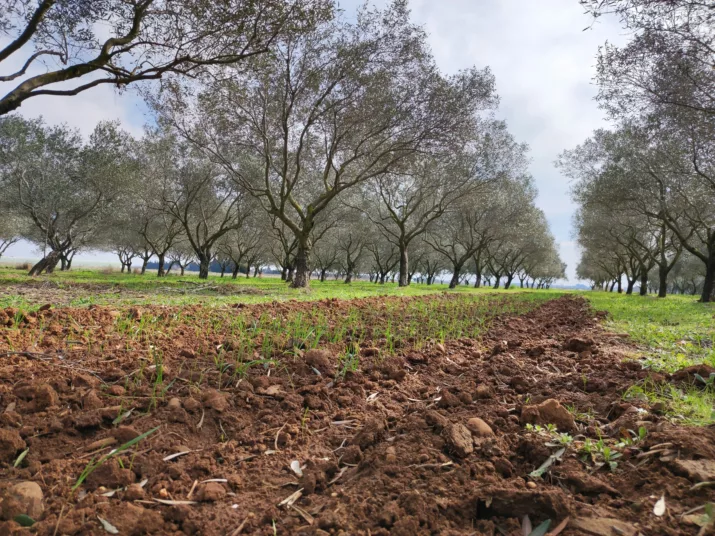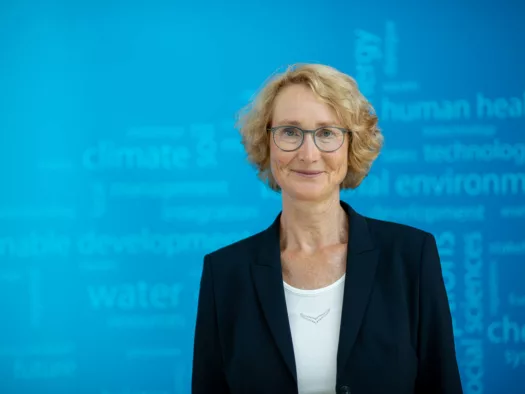
Foto von Nicolas Barbault auf Unsplash
Katrin Böhning-Gaese on agriculture and nature conservation and why a change in land use is inevitable
Land use in transition: between biodiversity and yield
Land-saving or land-sharing? How can nature conservation and food production be reconciled? And what is actually behind the term “land transition”? We talked to Prof. Dr. Katrin Böhning-Gaese - biologist, ornithologist and Scientific Director of the Helmholtz Centre for Environmental Research (UFZ) - about these and other questions.

Foto von Nicolas Barbault auf Unsplash
What are the biggest challenges in nature conservation?
Katrin Böhning-Gaese: I see two: firstly, the increasing land use conflicts. For every area, the question arises as to whether it should be left to nature or used for agriculture, forestry or energy production. Because land is limited and demands are growing, these conflicts are increasing noticeably. It is also about the implementation of nature conservation on the ground. Directives from above are no longer enough - solutions are needed that are developed locally. This is laborious, but necessary.
What role does agriculture play in nature conservation?
Böhning-Gaese: Around half of Germany's land is used for agriculture - as fields, meadows or pastures. Agriculture therefore plays a key role in nature conservation: this is particularly evident in traditional cultural landscapes. In the Rhön, open grazing areas for Rhön sheep have always preserved a species-rich landscape. The flowing landscape of the Spreewald is used both for growing vegetables - such as the famous Spreewald cucumbers - and for tourism. Nature conservation can also be implemented in intensive food production - the decisive factor is how agriculture is practiced. Organic farming promotes biodiversity more strongly, but biodiversity can also be increased in conventional farming.
Prof. Dr. Katrin Böhning-Gaese is a biologist, ornithologist and Scientific Director of the Helmholtz Centre for Environmental Research (UFZ)Ph

Photo: Sebastian Wiedling
How can this work in conventional farming?
Böhning-Gaese: A good example is the F.R.A.N.Z. project, in which the German Farmers' Association is also involved. It shows that simple measures - such as flower strips, hedges, fallow land or open watercourses - can also increase biodiversity in conventional farming. In some cases, just a few years are enough to achieve noticeable effects. In cereal cultivation, so-called “lark windows” can provide a habitat for species such as the skylark. It is crucial that measures are adapted to local conditions.
What do you think about the concepts of “land-saving” and “land-sharing” and what exactly do they mean?
Böhning-Gaese: Both land-saving - i.e. the separation of nature conservation and production areas - and land-sharing, where both take place on the same area, are necessary. The frequent juxtaposition therefore falls short. We need productive agriculture in order to secure food supplies. This was recently demonstrated by the war in Ukraine, when the collapse in grain production there caused immediate shortages. At the same time, we need to keep an eye on biodiversity - not only out of ethical responsibility, but also out of self-interest: Fertile soils, stable ecosystems and biodiversity are the basis of any long-term food production.
Many farmers are willing to take on responsibility.
What specific role do farmers play in nature conservation?
Böhning-Gaese: Farmers hold a large part of the solution in their hands - or under the plow. How they cultivate their land determines the state of biodiversity. Many farmers are willing to take responsibility. But they are under great pressure: economically, from bureaucracy, and increasingly also structurally - many farms cannot find successors. They often do not even own the land themselves, but lease it. In addition, subsidies are often counterproductive because they reward ownership rather than performance.
What needs to change politically?
Böhning-Gaese: A key lever is the EU's Common Agricultural Policy (CAP), through which Germany receives around 7 billion euros a year. Currently, most of this money is allocated according to area - large farms benefit, small ones receive less. Scientific bodies are calling for these funds to be linked more closely to public benefits - such as biodiversity, climate or water protection. There are practical proposals, including from the agricultural sector itself, on how this could be easily implemented.
Society often lacks awareness of this conflict of objectives - because supermarket shelves are still full.
What does the term “Landwende” mean - and why is it so unknown?
Böhning-Gaese: The “Landwende” describes the necessary change in the use of our land. The term was coined by the German Advisory Council on Global Change (WBGU). Land is a limited and increasingly contested resource and, unlike energy, cannot be increased in a short space of time. Nevertheless, there is often a lack of awareness of this conflict of objectives in society - because supermarket shelves are still full. However, rising prices for cocoa, olive oil and oranges are already showing the consequences of climate-related declines in production.
What can each individual do?
Böhning-Gaese: Nature conservation starts on a small scale - on the balcony or in the garden: flowering plants such as lavender or sage, native shrubs, wild corners instead of English lawns create space for insects and birds. Our consumption is also crucial: a plant-based diet reduces the pressure on land enormously - one kilogram of beef requires up to 160 times more land than one kilogram of potatoes. If you eat meat, you should choose regionally reared grazing animals. And: avoid wasting food - that is also active nature conservation.